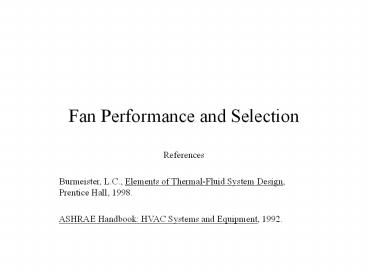Fan%20Performance%20and%20Selection - PowerPoint PPT Presentation
Title:
Fan%20Performance%20and%20Selection
Description:
Fan Performance and Selection References Burmeister, L.C., Elements of Thermal-Fluid System Design, Prentice Hall, 1998. ASHRAE Handbook: HVAC Systems and Equipment ... – PowerPoint PPT presentation
Number of Views:79
Avg rating:3.0/5.0
Title: Fan%20Performance%20and%20Selection
1
Fan Performance and Selection
- References
- Burmeister, L.C., Elements of Thermal-Fluid
System Design, Prentice Hall, 1998. - ASHRAE Handbook HVAC Systems and Equipment, 1992.
2
Overview
- Common fan types centrifugal (squirrel cage),
axial, special designs (including radial) - Fan rotation direction (clockwise or
counterclockwise) is important because the blades
and housing are designed to direct flow only in
one direction - Pressure drop through the system must be known to
choose a fan. - Fans are quietest when they operate near peak
efficiency efficiencies are often provided on
fan curves. - We will only look at axial fans here because they
are the most common type used in electronics
cooling.
3
Axial Flow Fans
- Common types propeller, tubeaxial, vaneaxial
- Tubeaxial impeller is inside a tube to guide
airflow and improve performance - Vaneaxial like a tubeaxial except vanes either
up or downstream of the impeller are used to
reduce swirl and improve performance - Used to deliver large flow rates but small
increase in pressure - Examples include fans used for ventilation
without ductwork, mobile room fans, and fans used
to cool computers
4
Tubeaxial fan for computer cooling
Tubeaxial fan for ventilation
Vaneaxial fan for high air resistance electronics
cooling Straightening vanes are located inside
tube
5
Vaneaxial Flow Fan
Source ASHRAE Handbook
6
System Pressure Effects
- Fan curves are typically given in terms of total
pressure vs. volumetric flow rate - A typical fan running at a fixed speed can
provide a greater volumetric flow rate for
systems with smaller total pressure drops (if
were to the right of the peak in the fan curve). - Total pressure lossstatic pressure lossdynamic
pressure loss - If exit and inlet area of a duct are about the
same, the dynamic pressure loss (or gain) may be
minimal.
7
Fan Curves
- Manufacturer will provide a fan curve for each
fan he or she produces. - The fan curves predict the pressure-flow rate
performance of each fan. - Choose a fan that gives you the volumetric flow
rate you need for your system pressure drop. - Choose a fan that has its peak efficiency at or
near your operating point. - Sometimes will provide data in a table rather
than in a graph.
8
Fan Curves
Source ASHRAE Handbook
9
Generalized Fan Curves
- These kinds of curves can be used to help choose
a fan.
Source Burmeister
10
Fan Laws
- Fan data for geometrically similar fans can be
collapsed onto a single curve using dimensionless
numbers
11
Fan Laws
- The laws only apply to aerodynamically similar
fans at the same point of rating on the
performance curve. - Under these conditions, the dimensionless
parameters will be constants. For example, if fan
operation moves from point 1 to point 2, the
values of the dimensionless parameters will not
change and thus can be used to estimate system
effects. - Be careful about using the fan laws to determine
the effect of fan speed change you may move to
a very different spot on the performance curve,
which will invalidate your results.
12
Fan Laws
- It may be easier to see how these work in a
different form
Source ASHRAE Handbook
13
Fan Laws
- Law 1 relates to effect of changing size,
speed, or density on volume flow, pressure, and
power level - Law 2 relates to effect of changing size,
pressure, or density on volume flow rate, speed,
and power - Law 3 shows effect of changing size, volume
flow, or density on speed, pressure, and power
14
Fan Law Example
- This example applies the fan laws to a case
where the fan speed N is changed from 600 to 650
RPM for a fan of a given size.
Source ASHRAE Handbook
15
Fan Law Example
- At point D Q26000 cfm and Pt21.13 in of water
- From Fan Law 1a, at point E
- Q16000x650/6006500 cfm
- From Fan Law 1b, at point E
- Pt11.13x(650/600)21.33 in of water
16
Two Fans in Parallel or Series
- For two identical fans in parallel, you can make
your own fan curve by taking the original fan
curve and doubling the volumetric flow rate for a
given pressure. - For two identical fans in series, you can make
your own fan curve by doubling the pressure drop
for a given volumetric flow rate. - Which would be better for cooling computer
chasses? - Watch out If in parallel you place your fans
too near, their in- and outflows will tend to
interfere. Tony Kordyban
17
Fans in Series and Parallel































